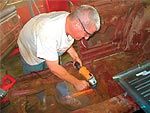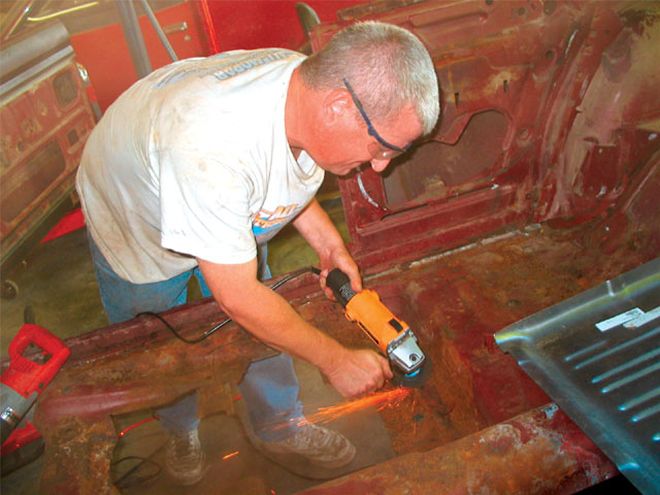
 We introduced our latest project in the October issue, and you'll remember that our floors needed to be repaired before we could begin building our bracket racer. This month we'll replace the sheetmetal in our Barracuda's floors and make it a structurally sound foundation for our race car build.
We introduced our latest project in the October issue, and you'll remember that our floors needed to be repaired before we could begin building our bracket racer. This month we'll replace the sheetmetal in our Barracuda's floors and make it a structurally sound foundation for our race car build.
Since most classic Mopars are nearly forty years old, it's no wonder the cars we find to build or restore have incurred some type of damage in their lives. Some have succumbed to accidents, warping and buckling their sheetmetal, and some to wear caused by many miles of use and abuse, but the main destroyer of vintage Mopar iron is rust. Depending on where you live, the cars in your area may be rusted out completely or suffer only minor damage. Cars in regions of the country where it snows regularly are usually the worst with rusted quarters, frames, and floor pans due to being driven through the salt used to melt snow from the roads. Southern cars usually fair a little better, but can have rust issues as well since the hot sun bakes the paint, leaving the sheetmetal exposed to the elements. Cars in coastal regions often don't fair any better than the ones up north as the salty air and driving on salt water laden beaches can also wreak havoc on body panels.
Our latest project, the B3 Bomber, is a Florida car and spent its entire life in the sunshine state. Fortunately, the Florida sunshine was pretty easy on our Barracuda, and the outer sheetmetal and frames are in pretty good shape. Unfortunately, our car's floorboards were almost completely rusted away and needed to be replaced.
There are many reasons a car's floors will rust. salty roads will certainly do it, as will driving on salty beaches without thoroughly cleaning your car afterwards. But there are other reasons that a car's floors will rust out. We've seen cars with no apparent external body rust with floors that are completely gone. Other than driving on salty roads or beaches, there are two basic reasons a car will have rusty floors, and both begin with the car sitting idle for a long period of time. It is common for older cars to be parked with good intentions of repairing them one day, only to find the car sits idle due to the owner's lack of interest or lack of funds. Cars that are in a garage get moved to the yard to make space and are subsequently subjected to the elements. A car parked in the grass will certainly be prone to vegetation growing under and around it, and that vegetation transfers moisture in the form of rain and dew to the bottom of the car's floors. Over time this will begin to rust the floors from underneath, and with enough time, the floorboards will be rusted away. The other problem with leaving a car sitting outside is that most old cars leak water. Weather stripping shrinking and rotting, windows left down or broken, and outer body rust-through allowing water into the car all contribute to water accumulating on the car's floors. Carpet acts like a sponge and traps the water on top of the floors, not allowing it to evaporate. This can be prevented by pulling the rubber plugs from the floors, allowing the water to drain, but most owners don't think about that when they park their vehicles. The result is, again, rusted-out floorboards
No matter what the cause, structural rust repairs should be one of the first steps of your restoration or build. Rust, especially in the frame and floor areas of the car, is not only unsightly, but can also be a safety hazard when driving your car. Remember that most Mopars, our Barracuda included, don't have a frame per se, so the frame sections, along with the floors, roof, and firewall, form the structure of these cars. This type of construction is a unit-body, or commonly called "unibody" construction and requires that the floors be intact to give the car its rigidity and structure. Having solid floors and framerails is even more important if you're going to install a high-horsepower engine as we are in our bracket race car. Much of the force of the car's rearend is transferred forward through the leaf springs and framerails to the floors of the car. Rusted or missing floors can cause all kinds of problems, up to and including actually twisting the car and causing permanently damaged framerails and rocker panels. Fortunately, new sheetmetal is available to repair most floor damage, and the repairs aren't technically complex. Our Barracuda needed both front floor panels, as well as the passenger side rear panel. We also needed to repair damage in the under-seat area of the passenger side of our car, but no pre-stamped panels were available, so we fabricated patch panels out of sheetmetal. While this sounds like a big job, it's really not all that hard. If you have a welder, grinder, drill, a metal saw, and even marginal technical skills, you should be able to handle it.
The first step to rust repair is to evaluate your car and then find out what panels are available to repair it. Being able to purchase prestamped panels for the repairs is definitely more cost effective than fabricating them out of sheetmetal, which can be very labor intensive. Our car needed both front floors, as well as one rear floorpan. The other rear pan was questionable, so we decided to get it in case we opted to replace it. A quick check of the Paddock catalog verified that all our sheetmetal was available, so we called them up and placed our order. One nice thing about floor repairs is that the parts are relatively inexpensive. By ordering our parts through the Paddock and performing the labor ourselves, we had our floors in great shape for a little over 300 bucks. parts for each model are priced differently, so be sure to check the Paddock's catalog or web site (paddockparts.com) for current pricing on parts for your vehicle. our parts arrived quickly, so we were ready to get to work.
Replacing floorpans is really almost as simple as just cutting the old floor out, fitting the new panel, and welding it in. There are some tools you'll need and some preparation you'll need to do before beginning the job. First, the car should be placed on four jackstands under the front and rear framerails and leveled. We used a carpenter's level on the rockers in the door opening and on the cowl below the windshield, and shimmed our jackstands with sheetmetal to get our car level. Leveling the car ensures the car doesn't flex or move when you cut the old floors out, and stays true as the new panels are welded in. Next, you must determine how much of the original floor needs to be removed due to rust. We try to remove as little of the original panel as possible, leaving as much of the factory's steel in place (very little could be saved in our case) for structural integrity. Use tape or a Sharpie to mark the floor where it needs to be cut out, and use a plasma cutter, saws-all, or jigsaw with a metal blade to cut the floor out. A die grinder with a cutting wheel may be necessary to get to places the saw can't reach, and if the floor needs to be removed from its edge or over frame sections, you'll need a spot weld cutter to remove the factory spot welds.
With the old panel out, the new one can be placed on or under it, and marked to be cut to fit. There are a couple of methods here depending on the result you desire. The new panel can be cut to the actual size of the hole and then butt-welded in. The welds can then be ground flush so the repair is nearly invisible. This method works well on restorations where a factory appearance is desired. The method we used is to overlap the new floor over the original slightly, then weld both the top and bottom sides, creating a double weld that holds the new floor in place. This method won't give the factory appearance that butt-welding will, but in our opinion gives a stronger end result and is more appropriate for our racing application.
Once the new floors are welded in they can be treated with rust inhibitor, primed, and painted to prevent them from rusting again. Treating the new, raw metal floors with rust inhibitor is an important step as it chemically makes the metal's surface resist rusting. Priming and painting the metal after treating it should ensure that your new floors last the life of the car if taken care of properly. We used OSPHO to treat our floorpans and then primed them with a quality primer. As our project proceeds, we'll paint the floors when we paint the rollcage and the rest of our interior, which will give our Barracuda better corrosion protection than it had when it left the factory.